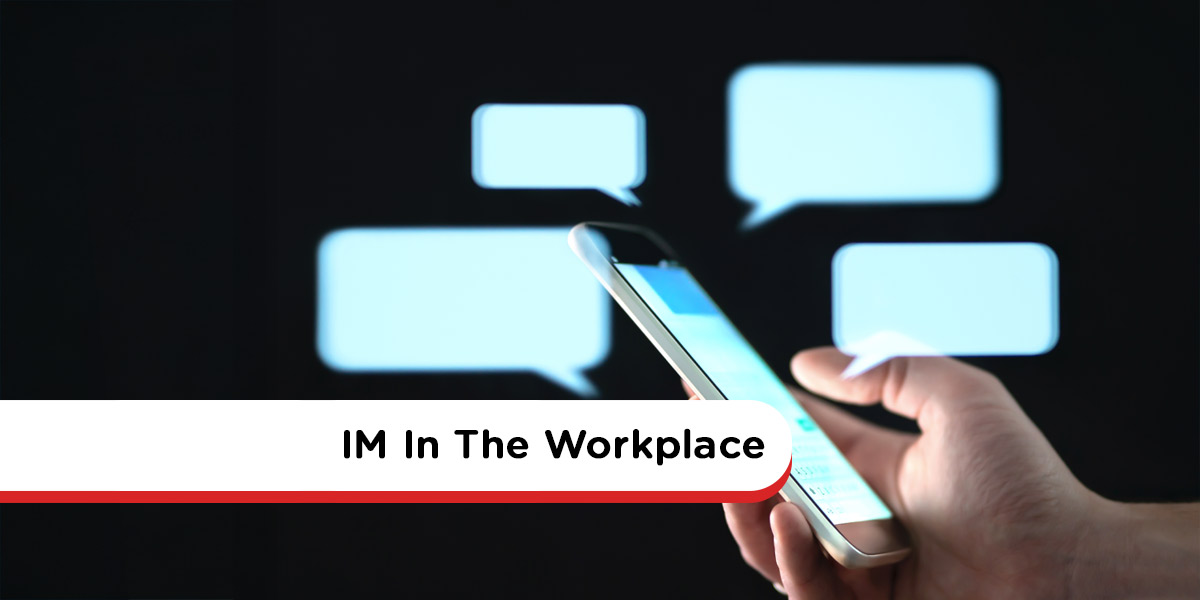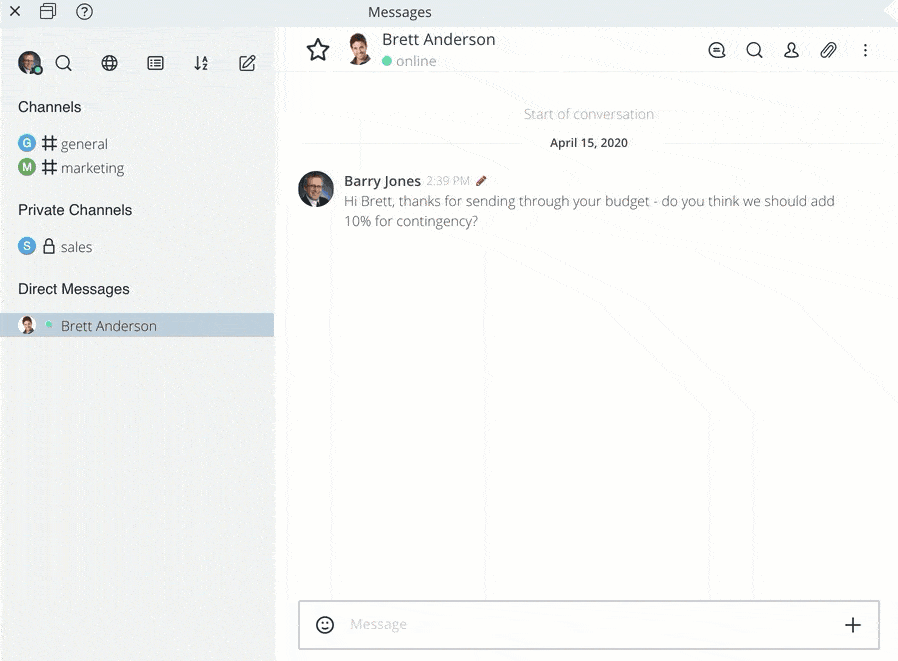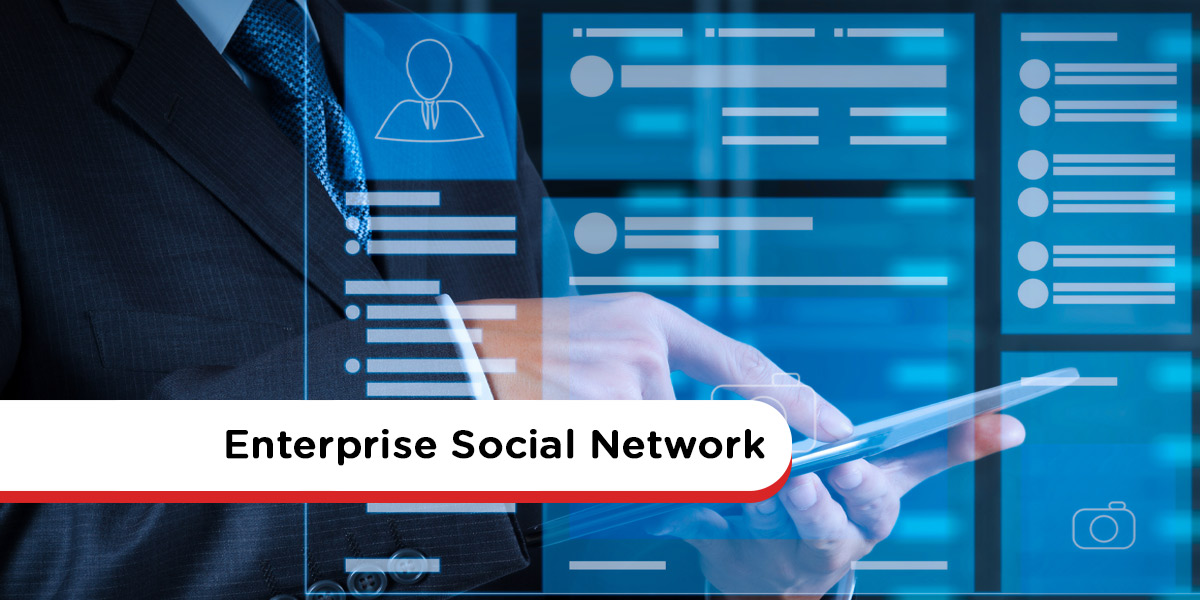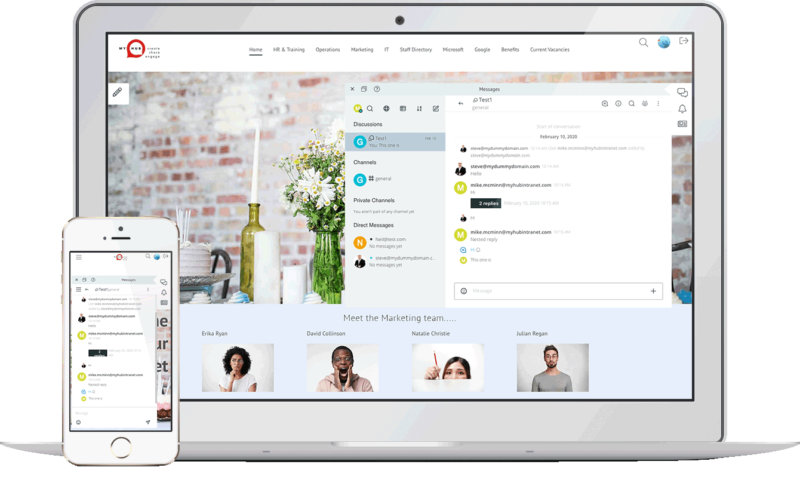
Your New Intranet Starts Here
Streamline communication, boost collaboration, and empower your team with MyHub's intuitive intranet solution.
Book a live demo now and experience the difference.
Take a Quick TourInstant messaging has become a staple in modern workplaces. That familiar ping of a message notification is now as common in offices as it is in our personal lives. In fact, global user accounts have surpassed eight billion. So it’s no surprise that business instant messaging apps are surging in popularity. Fast, efficient, and user-friendly, what’s not to love?
There’s no doubt that instant messaging platforms offer enormous potential as internal communication tools. Many companies use them to connect distributed teams, support hybrid working, and enhance customer interactions. However, while there are clear advantages, there are also important limitations to consider.
This guide covers everything you need to know about using instant messaging in the workplace, so you can make an informed decision for your organization.
In this post, you’ll learn about:
- The pros and cons of instant messaging in the workplace
- Essential ground rules for successful implementation
- Popular business messaging platforms to consider
What Is Business Instant Messaging?
Business instant messaging software enables employees to send and receive messages in real-time, whether via text, voice, or video. Most platforms also offer advanced features such as screen sharing, file sharing, and video conferencing capabilities.
Messages can be one-on-one or shared with groups via private or public chat channels. The best instant messaging apps support team collaboration through searchable, persistent chat spaces, available across desktop and mobile devices.
What Are The Benefits Of Instant Messaging At Work?
Instant messaging at work provides a fast, flexible communication channel that eliminates the need for formal emails or time-consuming meetings. It enables employees to connect instantly, no matter where they are or what they’re wearing (goodbye dress codes!).
Real-time communication helps speed up workflows, resolve issues faster, and streamline internal decision-making, saving time and increasing efficiency.
Real-Time Internal Communications
In today’s fast-paced work environment, being able to make quick decisions is crucial. With a real-time messaging app, teams can instantly discuss project updates, roadblocks, and next steps, without delays from email back-and-forth or missed calls.
Group chats are especially effective in hybrid or remote work settings, where employees are spread across different time zones and locations. Unlike email, which can be delayed or overlooked, or phone calls, which interrupt workflows, instant messaging delivers direct, informal communication without disruption.
Presence indicators (like “active now”) mean colleagues know when others are available. Short, focused messages get to the point quickly, without the need for formal greetings or email etiquette. Plus, features like @mentions, channels, and push notifications ensure messages reach the right people at the right time.
Considering a VoIP business phone system? Explore alternatives to phone.com for added communication flexibility.
Improved Productivity And Efficiency
Workplace messaging apps help reduce email clutter and phone calls, which often slow down productivity. Instant responses mean issues are resolved faster, and workers can provide immediate feedback, even with a simple emoji.
According to one survey, 21% of employees reported a significant boost in productivity from instant messaging. Top benefits cited included reduced call/email volume (75%) and faster resolution of questions (66%).
Moreover, instant messaging enhances team collaboration. File sharing is seamless, messages are searchable, and tasks can be assigned in real time. Whether public or private, chat channels foster transparency and agility, making them a valuable part of any digital workplace.
Ultimately, instant communication supports a more responsive, adaptable business. In a competitive market, that kind of speed is a game changer.
Promotes Social Relationships And Team Spirit
With hybrid working now the norm, many employees feel disconnected from colleagues. A recent McKinsey report found that over half of workers now prefer flexible work arrangements. This makes social interaction more challenging, but also more critical.
Corporate instant messaging helps maintain those “watercooler moments.” Dedicated #coffeebreak or #random channels encourage informal conversations that build trust and foster a sense of belonging.
From discussing weekend plans to celebrating team milestones, casual chat keeps morale high, even when teams are distributed. Plus, mobile access ensures frontline or on-the-move workers aren’t left out of the loop, supporting a truly inclusive culture.
Best of all? Most employees are already familiar with instant messaging. Whether it’s Slack, Teams, or WhatsApp, they’re comfortable with the interface, and ready to engage using emojis, GIFs, and hashtags.
Enhanced Customer Service
Instant messaging tools don’t just benefit your internal teams, they can also improve your customer service. Real-time internal messaging enables front-line staff to quickly get approvals or updates needed to assist customers.
Instead of placing a customer on hold or waiting for an email response, your service team can ping a manager for instant help. The result? A smoother support experience, faster response times, and more satisfied customers.
What Are The Disadvantages Of Business Instant Messaging Apps?
Before implementing business instant messaging, it’s important to weigh the potential downsides. While these platforms offer many benefits, they are not without challenges. Chief among them? Employee distraction.
Potential For Distraction
It’s true that the constant pings from team messaging apps can pull employees away from deep work. However, distractions come in many forms, phone calls, email notifications, or impromptu desk visits.
The good news is most instant messaging platforms include built-in features to reduce distraction. Employees can set their status (e.g., “busy” or “do not disturb”), mute notifications, and choose which conversations or channels to follow. Teams can also establish clear ground rules to manage workplace chat etiquette and minimize interruptions.
Security Risks
Third-party messaging apps may introduce security vulnerabilities. These platforms can be exposed to malware, data breaches, or unauthorized access. To protect your business, choose platforms with end-to-end encryption, enforce strong password policies, and limit access to sensitive data. Closed networks and secure authentication protocols are essential for safeguarding confidential company information.
Integration Challenges
With so many messaging platforms for business available, integration can become a stumbling block. Most apps operate as standalone solutions and may not communicate across systems. Your sales team might use CRM-integrated chat, while marketing prefers WhatsApp or Slack.
Ensure your chosen messaging tool integrates seamlessly with existing business software, including collaboration, project management, and productivity tools. Without integration, you’ll risk siloed communication and fragmented workflows, which can reduce overall efficiency.
Over-Reliance On Instant Messaging
Instant messaging apps are ideal for quick chats, updates, and rapid decision-making. However, they should not replace every form of workplace communication. Relying solely on IM can make internal interactions feel impersonal or even isolating.
Face-to-face meetings, whether in person or virtual, remain vital for building trust and engagement. Similarly, critical updates, HR policies, or corporate documents are better delivered via structured channels like an intranet platform. Use instant messaging strategically as one part of a broader communication toolkit.
Ground Rules For Instant Messaging In The Workplace
You can avoid many of the disadvantages above by establishing clear guidelines. These ground rules should be part of your digital workplace policy and regularly revisited during staff training.
Define Appropriate Content
Set clear expectations around what’s acceptable in business chats. For instance, sharing jokes, memes, or GIFs may be fine in a #coffeebreak channel, but should be avoided in professional discussions. Above all, ensure your policy includes zero tolerance for bullying, harassment, or inappropriate content.
Respect Work-Life Boundaries
Messaging apps can blur the line between work hours and personal time. Since messages may feel more urgent than emails, it’s essential to define when it’s appropriate to reach out. Encourage staff to be mindful of time zones, after-hours messaging, and response expectations.
Help your team differentiate between high-priority and non-urgent messages. Add phrases like “no rush” or “when you have time” to lower urgency. For important issues, make timelines explicit, e.g., “Please approve by 11 a.m. ahead of the 2 p.m. board meeting.”
Minimize Noise And Overload
Help staff manage notification overload by teaching them how to organize chats effectively. Consolidate communication by reducing the number of unnecessary channels and threads. Offer training on muting, prioritizing conversations, and customizing alerts for better focus and productivity.
Make sure your messaging etiquette is part of your employee onboarding program so that everyone is aligned from day one.
Avoiding Excessive Chit Chat
It’s a common concern, employees spending too much time sharing memes or chatting off-topic. But remember, especially for remote or hybrid teams, instant messaging fills a vital social gap.
Loneliness and disconnection are real challenges for telecommuters. Rather than banning personal conversations, manage them. Create dedicated channels like #timeout or #watercooler to encourage casual interactions in the right spaces.
Foster a culture that values connection. Schedule 15-minute daily or weekly chat breaks to build relationships and encourage morale-boosting dialogue. Informal conversations play a key role in team cohesion, collaboration, and employee engagement.
13 Must-Have Business Instant Messaging Features
So, what are the essential features every business IM platform should include? Let’s explore the most important functionalities that define a modern, effective instant messaging tool.
- Public or Private Chats: Your IM platform should support both public and private conversations. Public channels are great for team-wide announcements, while private chats are essential for sensitive discussions like strategic planning or HR matters.
- Channels: Enhance content relevancy and organization with topic-specific #channels. Whether it’s #HR, #Marketing, or #Sales, users can follow the discussions that matter most to their roles, while admins can control access visibility.
- Threads: Threads allow for focused, short-term topic discussions within broader channels. They’re ideal for conversations like planning the holiday party or collecting feedback on an upcoming wellness program.
- Direct Messaging: Employees can send private one-on-one messages to coworkers. These messages are instantly accessible on both desktop and mobile, enhancing real-time communication.
- Mentions: Use @mentions to directly notify team members, assign tasks, or draw attention to important updates, improving communication flow and project accountability.
- Social Features: Built-in social elements like emojis, reactions, and informal channels (e.g., #coffeebreak) help strengthen team culture and keep employee engagement high.
- Online Status: Easily identify who’s available with real-time status indicators. Tags like “active,” “busy,” or “away” allow colleagues to communicate appropriately and respect each other’s time.
- Easy Search: A robust search functionality should let users locate past messages, files, or conversations across threads, channels, and dates. Bonus points for print or export options for recordkeeping.
- Customizable Notifications: Users should be able to customize when and how they receive alerts. From muting noisy channels to enabling push notifications for urgent topics, flexible notification settings are key.
- File-Sharing Capabilities: Enable seamless file and video sharing within chats. Whether it’s documents, images, or spreadsheets, integrated sharing improves efficiency and collaboration.
- Single Sign-On (SSO): Integration with your intranet or enterprise systems via SSO authentication streamlines user experience and reduces login fatigue. It also boosts data security across platforms.
- Simple to Set Up: Look for user-friendly IM tools with intuitive onboarding and admin settings. A great platform should be easy to roll out, no complex IT setup required.
- Security Features: Prioritize platforms that offer end-to-end encryption, firewalls, and VPN compatibility. With rising cybersecurity threats, robust protection of sensitive business and personal data is non-negotiable.
Top Instant Messaging Apps For Business
A quick online search reveals dozens of popular messaging tools, but not all are suitable for the workplace. Here’s a curated list of the best business instant messaging apps based on functionality, security, and business value.
Slack
Slack remains a favorite in the world of business messaging, offering real-time text, video, and voice communication. It features everything from threaded conversations and channel tagging to advanced app integrations and enterprise-level security with end-to-end encryption.
It’s powerful but may not be ideal for small teams or startups due to its pricing. Some integrations also require third-party tools, which could increase complexity and cost.
Microsoft Teams
With over 270 million users, Microsoft Teams is the leading enterprise communication platform. Seamlessly integrated with Microsoft 365, it combines chat, video conferencing, file sharing, and collaborative workspaces in one system.
It offers high-level data protection and compliance features. However, its setup can be time-consuming and may require additional support, something to consider for smaller businesses with limited IT resources.
Skype
Though less dominant now, Skype still holds value for businesses seeking affordable and reliable communication. It supports voice calls, video chats, screen sharing, and file exchange. While Skype for Business has been phased out, the consumer version is still viable for budget-conscious teams.
Google Chat
Part of Google Workspace, Google Chat enables text messaging, task management, and integration with Google Drive. It’s perfect for organizations already using Gmail, Docs, or Sheets, offering a consistent, cloud-based workflow.
However, Google has a history of short-lived messaging tools, including Google Hangouts. Time will tell if Google Chat will become a long-term player in the business IM space.
Best Instant Messaging Apps: Why An Intranet Is The Smart Solution
Before we wrap up this post, we couldn’t resist highlighting how a modern intranet platform offers the ultimate solution for internal instant messaging. Intranets check all the boxes when it comes to the advantages of business messaging, while helping mitigate potential downsides like distraction and security risks.
Integrated Team Chat
MyHub’s intranet solution includes a fully integrated team chat feature, meaning instant messaging is built right into your central digital workplace. There’s no need for multiple apps. A single-sign-on gateway gives employees seamless access to chat, file sharing, newsfeeds, and collaboration tools, all in one secure platform.
This level of integration ensures that internal communication is streamlined, consistent, and easy to manage. Team chat also works in harmony with company news updates, blog posts, and intranet forums to create a unified experience.
Enhanced Security & Data Protection
One of the biggest concerns with standalone messaging apps is security. With MyHub’s intranet chat, your organization benefits from enterprise-grade security features, including end-to-end encryption and secure cloud hosting. The private network environment adds an extra layer of protection against data breaches, phishing attacks, and unauthorized access.
Rich Messaging Features Employees Expect
Today’s employees want intuitive tools that feel as natural as texting. MyHub’s intranet chat system includes all the features your teams expect: public and private conversations, direct messaging, and fun social elements like #channels, @mentions, and emojis.
Users can also pin important threads to their personal chat wall for easy access and attach documents for instant file sharing. Plus, all chat conversations are fully searchable, making it fast and easy to retrieve critical information from past discussions.
Minimize Distraction, Maximize Relevance
Unlike generic messaging tools, intranet-based team chat empowers users with advanced personalization options. Staff can follow only the channels relevant to their role, join project-specific discussions, and set their own notification preferences.
Status indicators let colleagues know who’s available to chat, while customizable alerts and mute functions help reduce noise and avoid burnout. This balance ensures that messages remain relevant and timely, without overwhelming your team.
Is Instant Messaging In The Workplace Right For Your Business?
Whether you’re connecting hybrid teams, accelerating decision-making, or improving response times, instant messaging for business delivers fast, reliable communication. With the right ground rules in place, the benefits far outweigh the risks.
The real secret to success lies in selecting the right platform. An intranet with built-in chat offers an all-in-one solution that’s secure, user-friendly, and fully integrated into your company’s internal systems.
Curious about how this could work for your business? Explore MyHub’s instant messaging capabilities by signing up for a free demo or start a 14-day trial. Experience the power of integrated communication, without the hassle of switching between platforms.
FAQ
What are the main benefits of instant messaging at work?
Instant messaging enables real-time communication and faster decision-making, reduces email and call volume, supports hybrid teams, facilitates file sharing, and enhances informal social interaction.
What are common challenges when using workplace IM?
Distractions from constant pings, data security and compliance risks, fragmented communication channels, and the risk of losing depth without face-to-face engagement are common drawbacks.
How can companies make IM effective without it becoming a problem?
Establish ground rules: define appropriate uses and content, enforce respectful boundaries (e.g., no after-hours pings), secure chat platforms with encryption, and integrate IM with your intranet or collaboration tools.






